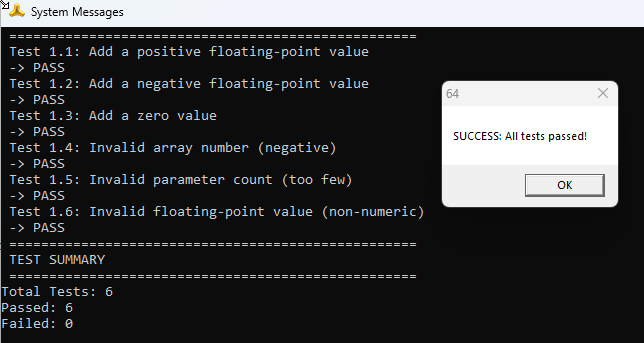MiniRobotLanguage (MRL)
ARR.Add Element FP
Append a Floating-Point Value to the End of a Floating-Point Array

Add a floating-point value to the end of a specified floating-point array, automatically resizing if necessary.
Intention
The ARR.Add Element FP command appends a mandatory floating-point value (P2) to the end of a specified floating-point array (P1). The command automatically resizes the array to accommodate the new element, making it ideal for dynamically building arrays of numeric data in tasks like scientific calculations, data collection, or statistical processing. The value is stored as a string internally, consistent with MRL’s array storage mechanism.
The command requires exactly two parameters: the array number and the floating-point value. The array is modified in-place, with the new element added at the next available index.
•Auto-Dim: If the array is not large enough, it is automatically resized to include the new element.
•Numeric Validation: The value (P2) is resolved to a floating-point number, ensuring proper numeric format.
•Mandatory Value: The floating-point value (P2) is required; omitting it results in no operation.
Schematic (Floating-Point Array Append)
Array[1]: ["1.23", "4.56"]
Command: ARR.Add Element FP|1|7.89
Result: Array[1]: ["1.23", "4.56", "7.89"]
Syntax
ARR.Add Element FP|P1|P2
Parameter Explanation
•P1 - Array Number: Specifies the floating-point array number, which can range from 0 to 32.
•P2 - Floating-Point Value: Specifies the floating-point value to append to the array. Must be a valid numeric string (e.g., "1.23", "-4.56").
Speed in Ticks:
This command typically uses between 100 to 250 ticks, depending on array size and resizing needs.
Examples
'***********************************
' Example 1: Add a floating-point value to an array
'***********************************
ARR.Set FP|1|0|1.23
ARR.Add Element FP|1|4.56
' Array 1 now contains: ["1.23", "4.56"]
ARR.Get|1|1|$$RET
MBX.$$RET
ENR.
'***********************************
' Example 2: Add a negative floating-point value
'***********************************
ARR.Set FP|2|0|0.0
ARR.Add Element FP|2|-7.89
' Array 2 now contains: ["0.0", "-7.89"]
ARR.Get|2|1|$$RET
MBX.$$RET
ENR.
'***********************************
' Example 3: Add a zero value
'***********************************
ARR.Add Element FP|3|0.0
' Array 3 now contains: ["0.0"]
ARR.Get|3|0|$$RET
MBX.$$RET
ENR.
'============================================================
' SELF-VALIDATING TEST SCRIPT for ARR.Add Element FP
' Purpose: Verify functionality with JIV. for automated checks.
' Tests adding floating-point values, negative values, invalid array numbers, and invalid parameters.
'============================================================
' Initialize counters
$$PAS=0
$$FAI=0
STS.CLEAR
PRT. ===================================================
PRT. Test 1.1: Add a positive floating-point value
STS.CLEAR
ARR.Clr|1
ARR.Add Element FP|1|3.14
ARR.Get FP Array|1|0|$$RET
$$EXP=3.14
JIV.$$RET!$$EXP|Lab_Error1
PRT. -> PASS
VIC.$$PAS
JMP.Lab_Next1
:Lab_Error1
GSB.Test
'-----------------------------------------------------------
:Lab_Next1
PRT. Test 1.2: Add a negative floating-point value
STS.CLEAR
ARR.Clr|2
ARR.Add Element FP|2|-2.718
ARR.Get FP Array|2|0|$$RET
$$EXP=-2.718
JIV.$$RET!$$EXP|Lab_Error2
PRT. -> PASS
VIC.$$PAS
JMP.Lab_Next2
:Lab_Error2
GSB.Test
'-----------------------------------------------------------
:Lab_Next2
PRT. Test 1.3: Add a zero value
STS.CLEAR
ARR.Clr|3
ARR.Add Element FP|3|0.0
ARR.Get FP Array|3|0|$$RET
$$EXP=0.0
JIV.$$RET!$$EXP|Lab_Error3
PRT. -> PASS
VIC.$$PAS
JMP.Lab_Next3
:Lab_Error3
GSB.Test
'-----------------------------------------------------------
:Lab_Next3
PRT. Test 1.4: Invalid array number (negative)
STS.CLEAR
ARR.Clr|4
ARR.Add Element FP|-1|1.23
ARR.Get FP Array|4|0|$$RET
$$EXP=0
JIV.$$RET!$$EXP|Lab_Error4
PRT. -> PASS
VIC.$$PAS
JMP.Lab_Next4
:Lab_Error4
GSB.Test
'-----------------------------------------------------------
:Lab_Next4
PRT. Test 1.5: Invalid parameter count (too few)
STS.CLEAR
ARR.Clr|5
ARR.Add Element FP|5
ARR.Get FP Array|5|0|$$RET
$$EXP=0
JIV.$$RET!$$EXP|Lab_Error5
PRT. -> PASS
VIC.$$PAS
JMP.Lab_Next5
:Lab_Error5
GSB.Test
'-----------------------------------------------------------
:Lab_Next5
PRT. Test 1.6: Invalid floating-point value (non-numeric)
STS.CLEAR
ARR.Clr|6
ARR.Add Element FP|6|Invalid
ARR.Get FP Array|6|0|$$RET
$$EXP=0
JIV.$$RET!$$EXP|Lab_Error6
PRT. -> PASS
VIC.$$PAS
JMP.Lab_Next6
:Lab_Error6
GSB.Test
:Lab_Next6
PRT. ===================================================
PRT. TEST SUMMARY
PRT. ===================================================
CAL.$$TOT=$$PAS+$$FAI
$$MSG=Total Tests: $$TOT
PRT.$$MSG
$$MSG=Passed: $$PAS
PRT.$$MSG
$$MSG=Failed: $$FAI
PRT.$$MSG
JIV.$$FAI=0|Lab_Success
$$MSG=FAILURE: $$FAI of $$TOT tests failed.
MBX.$$MSG|Test Result|16
JMP.Lab_End
:Lab_Success
MBX.SUCCESS: All tests passed!|Test Result|64
:Lab_End
ENR.
:Test
$$MSG= -> FAIL - Result: $$RET (exp: $$EXP)
PRT.$$MSG
VIC.$$FAI
RET.
Remarks
- The command automatically resizes the array if necessary, similar to the auto-dimensioning behavior of ARR.Set FP.
- Floating-point values are stored as strings internally, consistent with MRL’s array storage mechanism, allowing retrieval as numeric strings.
- The command modifies the array in-place and does not return a value.
- Invalid floating-point values (e.g., non-numeric strings) may result in no operation or default to 0.0, depending on implementation.
Limitations
- Array numbers are limited to 0–32, consistent with other MRL array commands.
- Invalid array numbers (e.g., negative or >32) result in no operation.
- The command requires exactly two parameters; fewer or more parameters result in no operation.
- No support for multidimensional arrays; use other commands for complex array structures.
- Non-numeric values for P2 may result in no operation or undefined behavior.
See also:
• Insert
• Swap
• Delete